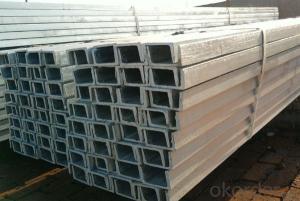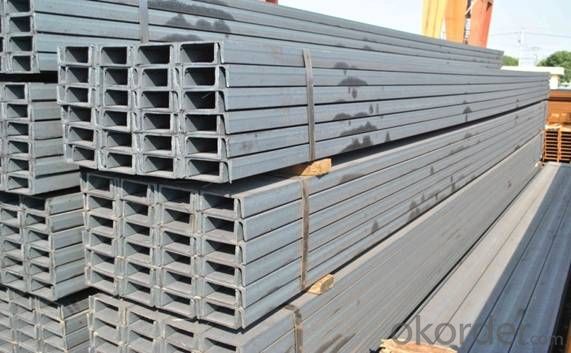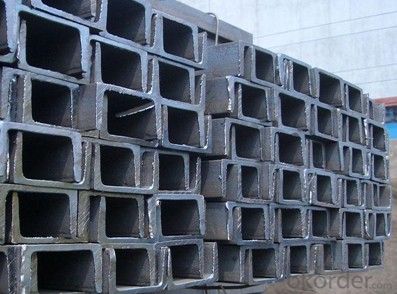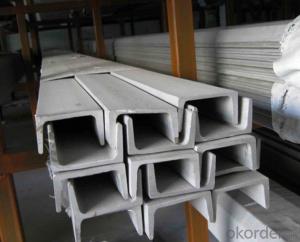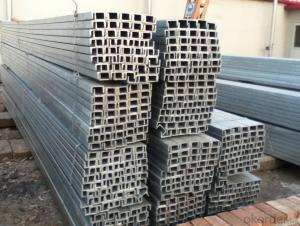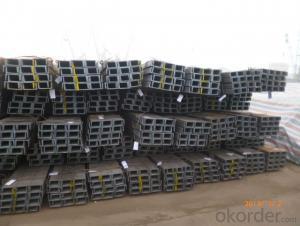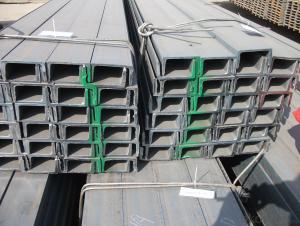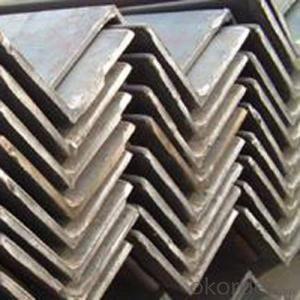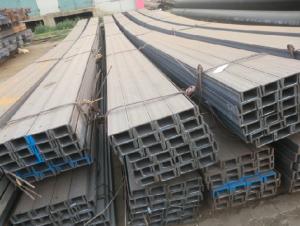Hot Rolled JIS U Channel High Quality for All Sizes
- Loading Port:
- Tianjin
- Payment Terms:
- TT OR LC
- Min Order Qty:
- 25 m.t.
- Supply Capability:
- 20000 m.t./month
OKorder Service Pledge
OKorder Financial Service
You Might Also Like
Product Description:
OKorder is offering Hot Rolled JIS U Channel High Quality for All Sizes at great prices with worldwide shipping. Our supplier is a world-class manufacturer of steel, with our products utilized the world over. OKorder annually supplies products to European, North American and Asian markets. We provide quotations within 24 hours of receiving an inquiry and guarantee competitive prices.
Product Applications:
According to the needs of different structures, Hot Rolled JIS U Channel High Quality for All Sizes can compose to different force support component, and also can be the connections between components. It is widely used in various building structures and engineering structures such as roof beams, bridges, transmission towers, hoisting machinery and transport machinery, ships, industrial furnaces, reaction tower, container frame and warehouse etc
Product Advantages:
OKorder's Hot Rolled JIS U Channel High Quality for All Sizes are durable, strong, and resist corrosion.
Main Product Features:
· Premium quality
· Prompt delivery & seaworthy packing (30 days after receiving deposit)
· Corrosion resistance
· Can be recycled and reused
· Mill test certification
· Professional Service
· Competitive pricing
Product Specifications:
Manufacture: Hot rolled
Grade: Q195 – 235
Certificates: ISO, SGS, BV, CIQ
Length: 6m – 12m, as per customer request
Packaging: Export packing, nude packing, bundled
Sizes: 25mm-250mm | ||||||||||
a*t | ||||||||||
25*2.5-4.0 | 70*6.0-9.0 | 130*9.0-15 | ||||||||
30*2.5-6.6 | 75*6.0-9.0 | 140*10-14 | ||||||||
36*3.0-5.0 | 80*5.0-10 | 150*10-20 | ||||||||
38*2.3-6.0 | 90*7.0-10 | 160*10-16 | ||||||||
40*3.0-5.0 | 100*6.0-12 | 175*12-15 | ||||||||
45*4.0-6.0 | 110*8.0-10 | 180*12-18 | ||||||||
50*4.0-6.0 | 120*6.0-15 | 200*14-25 | ||||||||
60*4.0-8.0 | 125*8.0-14 | 250*25 | ||||||||
FAQ:
Q1: What makes stainless steel stainless?
A1: Stainless steel must contain at least 10.5 % chromium. It is this element that reacts with the oxygen in the air to form a complex chrome-oxide surface layer that is invisible but strong enough to prevent further oxygen from "staining" (rusting) the surface. Higher levels of chromium and the addition of other alloying elements such as nickel and molybdenum enhance this surface layer and improve the corrosion resistance of the stainless material.
Q2: Can stainless steel rust?
A2: Stainless does not "rust" as you think of regular steel rusting with a red oxide on the surface that flakes off. If you see red rust it is probably due to some iron particles that have contaminated the surface of the stainless steel and it is these iron particles that are rusting. Look at the source of the rusting and see if you can remove it from the surface.
Q3: The products are invoicing on theoritical weight or on actual weight?
A3: We can do it in both manners, according to the customers' request.
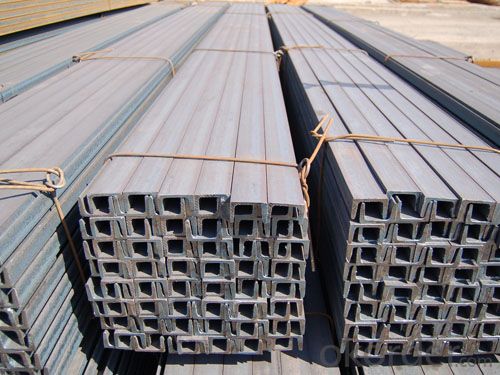
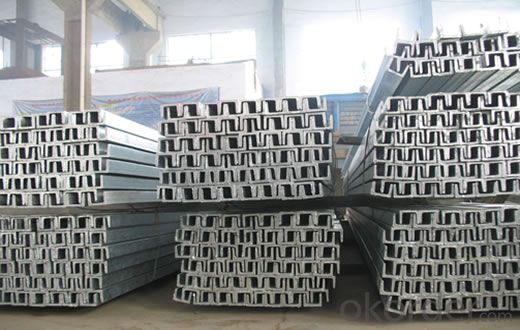
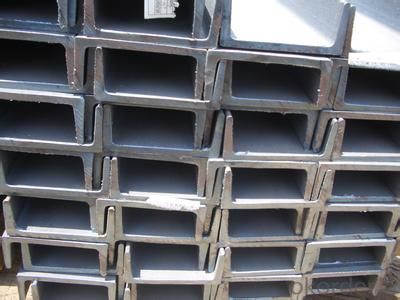
- Q: What are the different methods of painting steel channels?
- Painting steel channels can be done using various methods, each with its own advantages and considerations. Let's explore some of these methods: 1. Brush painting: The traditional and most basic method involves using a paintbrush to directly apply paint onto the channel's surface. This technique is ideal for smaller projects or areas that require precise detailing. However, it can be time-consuming and may result in brush marks or uneven coverage. 2. Spray painting: A popular method, especially for larger projects or areas that require a smooth and even finish, is spray painting. This technique involves using a spray gun or aerosol can to create a fine mist of paint that is sprayed onto the surface. Spray painting allows for quick and efficient coverage, even in hard-to-reach areas. However, it requires proper ventilation and protective equipment to ensure safety. 3. Powder coating: For a highly durable and long-lasting finish, powder coating is an excellent choice. This method involves applying a dry powder paint that is then cured with heat to create a protective and smooth finish. Powder coating provides excellent resistance against corrosion, chemicals, and UV rays. It is commonly used in industrial applications and offers a wide range of color options. However, it requires specialized equipment and expertise, making it more suitable for professional applications. 4. Electrostatic painting: Another technique is electrostatic painting, which utilizes an electrostatic charge to attract paint particles onto the steel channel's surface. A spray gun is used to produce a charged paint mist, which is then attracted to the grounded channel. This method ensures even coverage and minimizes overspray. Electrostatic painting is commonly used when a high-quality finish and uniform coating thickness are required. 5. Dip painting: For objects with complex shapes or hard-to-reach areas, dip painting is a suitable method. This involves immersing the steel channel into a container filled with paint, allowing the paint to evenly coat the surface. Dip painting can achieve a uniform finish but requires careful control of the immersion process to prevent excess paint buildup or drips. Each method has its own advantages and considerations. The choice of painting method depends on factors such as the project size, desired finish, durability requirements, and available resources. It is crucial to consider the specific needs and constraints of the project before selecting the most suitable method for painting steel channels.
- Q: How do steel channels contribute to the stability of cantilevered structures?
- There are several ways in which steel channels contribute to the stability of cantilevered structures. Firstly, their high strength and durability make them ideal for supporting heavy loads and resisting external forces. When used as a structural component in cantilevered structures, they provide the necessary support and stability to counteract the bending moments and shear forces that act on the structure. In addition, the U-shaped cross-section of steel channels enhances their load-bearing capacity and resistance to bending. This shape allows for a more efficient distribution of forces, preventing excessive deflection and ensuring the structural integrity of the cantilever. Steel channels are also commonly used in combination with other structural elements, such as beams and columns, to create a rigid framework. This framework provides additional support and stiffness to the cantilevered structure, preventing any excessive movement or deformation. Moreover, the versatility of steel channels allows for various configurations and connections, enabling engineers to design cantilevered structures with different shapes and sizes to meet specific requirements. This adaptability ensures that the structure can withstand different loads and environmental conditions, enhancing its overall stability. Finally, steel channels can be precisely fabricated, ensuring accurate alignment and assembly during construction. This precision minimizes any potential weak points or gaps in the structure, further enhancing its stability and safety. In conclusion, steel channels significantly contribute to the stability of cantilevered structures by providing high strength, load-bearing capacity, and resistance to bending. Their U-shaped cross-section, versatility, and precise fabrication also play crucial roles in ensuring the overall stability and integrity of these structures.
- Q: How do steel channels contribute to the structural integrity of a building?
- Steel channels contribute to the structural integrity of a building in several ways. Firstly, they provide additional support and reinforcement to the structural framework, enhancing its overall strength and stability. Secondly, steel channels help distribute the load evenly across the building, reducing the risk of structural failure due to uneven weight distribution. Additionally, steel channels are resistant to bending and twisting forces, making them ideal for withstanding high-pressure and seismic activities. Overall, steel channels play a crucial role in improving the durability and safety of a building's structure.
- Q: How do steel channels contribute to the durability of a structure?
- Steel channels contribute to the durability of a structure in several ways. Firstly, steel channels are made from a high-strength material which provides excellent resistance to external forces. This means that they can withstand heavy loads, impacts, and vibrations without deforming or breaking, ensuring the structural integrity of the building. Secondly, steel channels are designed with specific shapes and dimensions, allowing them to distribute the loads evenly across the structure. This helps in preventing localized stress concentrations, reducing the risk of fatigue failure over time. By evenly distributing the forces, steel channels can also minimize the potential for cracks or structural deformations, enhancing the long-term durability of the structure. Furthermore, steel channels offer superior corrosion resistance compared to other materials like wood or concrete. Steel is often protected with coatings or galvanized to prevent rust and corrosion, which can significantly extend the lifespan of the structure. This resistance to corrosion is particularly important in environments with high humidity, exposure to saltwater, or industrial pollutants. Another advantage of steel channels is their versatility and adaptability in construction. They can be easily fabricated and customized to fit the specific needs of a structure, including size, shape, and connection details. This flexibility allows for efficient construction and the ability to modify or expand the structure in the future without compromising its overall durability. Lastly, steel channels offer fire resistance, which is crucial for the safety and durability of a structure. Steel has a high melting point and does not contribute to the spread of fire, providing valuable time for occupants to evacuate and minimizing damage to the building. This fire resistance also reduces the need for extensive fireproofing measures, making steel channels a cost-effective solution for enhancing the durability of a structure. In summary, steel channels contribute to the durability of a structure by providing high-strength, even load distribution, corrosion resistance, versatility, and fire resistance. These qualities help ensure the longevity and safety of the building, making steel channels a valuable component in construction.
- Q: What are the different shapes of steel channels available?
- There are several different shapes of steel channels available in the market. Some of the common shapes include: 1. C-Channel: This is the most commonly used shape of steel channel, which resembles the letter "C". It has a flat base and two perpendicular sides. C-channels are versatile and widely used in construction and structural applications. 2. U-Channel: U-channels are similar to C-channels but have a slightly different shape, resembling the letter "U". They have a flat base and two perpendicular sides, but the sides are typically shorter than C-channels. U-channels are commonly used for edging, framing, and support purposes. 3. Hat Channel: Hat channels, also known as furring channels or resilient channels, have a unique "hat-like" shape, with a flat base and two parallel sides that taper towards the top. These channels are primarily used as a support system for attaching gypsum boards or other wall materials. 4. Box Channel: Box channels, also known as rectangular channels, have a square or rectangular shape. They have four equal sides and are often used for structural applications where strength and rigidity are required. 5. Z-Channel: Z-channels have a distinctive "Z" shape, with two parallel sides that are connected by a vertical middle section. These channels are commonly used in construction for framing, bracing, and supporting applications. 6. Lipped Channel: Lipped channels, also known as lip channels or lip sections, have an additional lip or flange on one side. This lip provides extra strength and rigidity, making lipped channels suitable for heavy-duty applications such as structural support and framing. These are just a few examples of the different shapes of steel channels available. The choice of shape depends on the specific application and the required strength and functionality of the channel.
- Q: What are the standard lengths of steel channels?
- The standard lengths of steel channels vary depending on the specific requirements and standards set by different industries and manufacturers. However, there are some commonly used standard lengths for steel channels, which are typically available in increments of 6 or 12 feet (1.83 or 3.66 meters). These standard lengths are widely used in construction, manufacturing, and other applications. Some commonly available standard lengths for steel channels include 20 feet (6.1 meters), 40 feet (12.2 meters), and 60 feet (18.3 meters). These lengths are convenient for transportation and handling, as well as for use in various structural or fabrication projects. It is important to note that while these are common standard lengths, steel channels can also be custom-cut to specific lengths to meet the unique requirements of a particular project. Additionally, there may be variations in standard lengths based on regional or industry-specific standards. Consulting the relevant industry standards, such as those set by organizations like the American Society for Testing and Materials (ASTM) or the American Institute of Steel Construction (AISC), can provide more specific information on the standard lengths of steel channels for a particular application.
- Q: What's the size of channel 16, please? Thank you!
- 16A - H height 160mm, B leg width 63mm, D waist thickness 6.5mm - sectional area 21.962/ square cm, weight 17.240kg/m16b - H height 160mm, B leg width 65mm, D waist thickness 8.5mm - sectional area 25.162/ square cm, weight 19.752kg/m
- Q: Can steel channels be used for signpost installations?
- Yes, steel channels can be used for signpost installations. Steel channels are commonly used in construction and engineering projects due to their strength, durability, and versatility. They provide a sturdy support structure for various applications, including signpost installations. Steel channels are capable of withstanding environmental factors such as wind, rain, and temperature changes, making them suitable for outdoor use. Additionally, their rigidity ensures that the signpost remains stable and secure. Overall, steel channels are an excellent choice for signpost installations, offering long-lasting support and reliability.
- Q: Can steel channels be used in the construction of automotive frames?
- Indeed, the utilization of steel channels in the fabrication of automotive frames is feasible. The construction industry frequently employs steel channels owing to their robustness, longevity, and adaptability. These channels offer exceptional structural reinforcement and can endure substantial burdens, rendering them apt for automotive frames. Additionally, steel channels possess remarkable resistance against bending and twisting forces, thus ensuring the stability and security of the vehicle. Moreover, the fabrication and welding of steel channels can be effortlessly accomplished, enabling efficient and economical production of automotive frames.
- Q: Do steel channels have any specific thermal expansion properties?
- Yes, steel channels do have specific thermal expansion properties. Like all materials, steel expands and contracts with changes in temperature. The thermal expansion of steel channels is primarily determined by the coefficient of linear expansion, which is a measure of how much the material expands per unit length per degree Celsius (or per unit length per degree Fahrenheit). The coefficient of linear expansion for steel typically ranges between 10 to 13 parts per million per degree Celsius (10-13 ppm/°C). This means that for every degree Celsius increase in temperature, a steel channel will expand by approximately 10 to 13 parts in a million of its original length. It is important to consider the thermal expansion of steel channels in various applications to ensure proper design and functionality. For example, in structures where steel channels are used, such as bridges or buildings, allowance must be made for the expansion and contraction of the channels to prevent stress buildup and potential damage. Expansion joints or other methods of accommodating thermal expansion are typically incorporated into the design to account for these properties. In summary, steel channels do exhibit specific thermal expansion properties, which are determined by the coefficient of linear expansion. Understanding and accounting for these properties is crucial in the design and application of steel channels to ensure their structural integrity and functionality in varying temperature conditions.
Send your message to us
Hot Rolled JIS U Channel High Quality for All Sizes
- Loading Port:
- Tianjin
- Payment Terms:
- TT OR LC
- Min Order Qty:
- 25 m.t.
- Supply Capability:
- 20000 m.t./month
OKorder Service Pledge
OKorder Financial Service
Similar products
Hot products
Hot Searches
Related keywords
